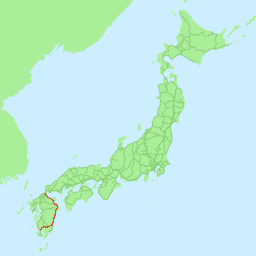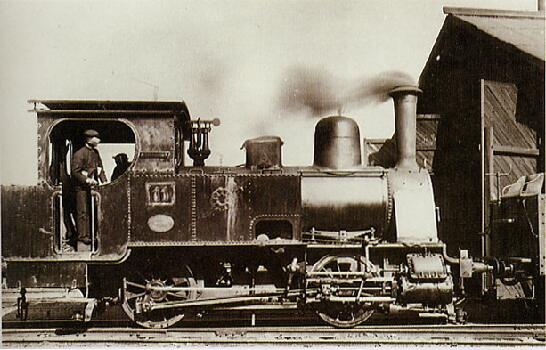|
Sōtarō Station
is a railway station in Saiki, Ōita, Japan. It is operated by JR Kyushu and is on the Nippō Main Line. Lines The station is served by the Nippō Main Line and is located 231.0 km from the starting point of the line at . Layout The station consists of two side platforms serving two track with a siding set on a side hill cutting in a remote mountainous area. The station is not staffed and there is no station building. A small shed and a public telephone call box are provided as a passenger shelter near the station entrance and another shelter is provided on the opposite side platform. The platforms are linked by a footbridge. file:Sotaro Station 3.JPG, A view of the station platforms looking north. file:Sotaro Station 2.JPG, A view of the station platform looking south. file:Sotaro Station Entrance.JPG, Station entrance. Note the box for collecting used tickets. Adjacent stations History The private Kyushu Railway had, by 1909, through acquisition and its own ... [...More Info...] [...Related Items...] OR: [Wikipedia] [Google] [Baidu] |
JR Logo (kyushu)
JR, J. R. or Jr. may refer to: * Jr. or Junior (suffix), a name suffix Arts and entertainment * ''J.R.'' (album), an album by Jim Bob * '' J R'', a 1975 novel written by William Gaddis * "Jr.", a song by Codeine on the album ''Barely Real'' * J. R. Ewing, a television character from ''Dallas'' * JR Chandler, aka Adam Chandler Jr, a television character from ''All My Children'' * '' Jornal da Record'', a Brazilian news program on RecordTV Businesses and organizations * Aero California, defunct Mexican airline by IATA code * Japan Railways Group or the JR Group, the main operators of the Japanese railway network * Jember railway station * John Radcliffe Hospital * Joy Air, Chinese airline by IATA code People In arts and entertainment * JR (artist) (born 1983), French artist * J.R. (musician) (born 1979), American Christian musician and producer * JR (rapper) (born 1987), South African rapper and entrepreneur * ''J. R.'' a pen-name of writer John Ruskin * ''Jr.'', stage na ... [...More Info...] [...Related Items...] OR: [Wikipedia] [Google] [Baidu] |
JR Kyushu
The , also referred to as , is one of the seven constituent companies of Japan Railways Group (JR Group). It operates intercity rail services within Kyushu, Japan and the JR Kyushu Jet Ferry Beetle hydrofoil service across the Tsushima Strait between Fukuoka and Busan, South Korea. It also operates hotels, restaurants, and drugstores across its service region. JR Kyushu's headquarters are in Hakata-ku, Fukuoka. ." Kyushu Railway Company. Retrieved on March 27, 2010. History When was divided in 1987, Kyushu Railway Company inherited its assets and operations on the island of |
Nippō Main Line
The is a railway line in Kyushu, in southern Japan, operated by Kyushu Railway Company (JR Kyushu). The line connects Kokura Station in Kitakyushu, Fukuoka, and Kagoshima Station in Kagoshima via the east coast of Kyushu, passing through the prefectural capitals of Ōita and Miyazaki. A number of Limited Express trains operate along the route, including Limited Express Sonic trains between Hakata and Oita. Stations :●: Stops :▲: Rapid service connecting to Hitahikosan Line non-stop, :|: Non-stop :Liner services: ''Sawayaka Liner'', ''Home Liner'' Though Kagoshima is the southern terminus for the line, some trains continue via the Kagoshima Main Line to the adjacent Kagoshima-Chūō station. History The Kyushu Railway Co. opened the 6 km Kokura - Jono section in 1895, and the Hōshū Railway Co. opened the 46 km Yukuhashi - Buzen Nagasu section in 1897. The former company acquired the latter in 1901, and was nationalised in 1907. The lines were connec ... [...More Info...] [...Related Items...] OR: [Wikipedia] [Google] [Baidu] |
Railway Station
Rail transport (also known as train transport) is a means of transport that transfers passengers and goods on wheeled vehicles running on rails, which are incorporated in Track (rail transport), tracks. In contrast to road transport, where the vehicles run on a prepared flat surface, rail vehicles (rolling stock) are directionally guided by the tracks on which they run. Tracks usually consist of steel rails, installed on Railroad tie, sleepers (ties) set in track ballast, ballast, on which the rolling stock, usually fitted with metal wheels, moves. Other variations are also possible, such as "slab track", in which the rails are fastened to a concrete foundation resting on a prepared subsurface. Rolling stock in a rail transport system generally encounters lower friction, frictional resistance than rubber-tyred road vehicles, so passenger and freight cars (carriages and wagons) can be coupled into longer trains. The rail transport operations, operation is carried out by a ... [...More Info...] [...Related Items...] OR: [Wikipedia] [Google] [Baidu] |
Saiki, Ōita
is a city located in Ōita Prefecture, Japan. The city was founded on April 29, 1941. On March 3, 2005, Saiki merged with the towns of Kamae, Kamiura, Tsurumi, Ume and Yayoi, and the villages Honjō, Naokawa and Yonōzu (all from Minamiamabe District) to create the new and expanded Saiki City. Minamiamabe District was dissolved as a result of this merger. As of March 2017, the new city has an estimated population of 73,546 (former city, 2003: 49,183) and a population density of 81 persons per km2. The total area is 903.44 km2, making it the largest city by area in Kyushu. Geography Climate Saiki has a humid subtropical climate (Köppen climate classification ''Cfa'') with hot summers and cool winters. Precipitation is significant throughout the year, but is somewhat lower in winter. The average annual temperature in Saiki is . The average annual rainfall is with September as the wettest month. The temperatures are highest on average in August, at around , and l ... [...More Info...] [...Related Items...] OR: [Wikipedia] [Google] [Baidu] |
Kyushu Railway
was a company that built and operated railways in Kyushu, one of four main islands of Japan. Most of its lines came under the control of Japanese Government Railways following nationalization in 1907, and many are now operated by Kyushu Railway Company. History The company was incorporated on August 15, 1888 in Fukuoka, Fukuoka. The first of the railway, between Hakata Station in Fukuoka and Chitosegawa temporary station in Asahi, Saga (near Kurume, Fukuoka), opened on December 11, 1889 as the first railway in Kyushu. The company expanded the railway by means of both construction and acquisition of other companies. As of 1907, it operated of railways in Fukuoka, Kumamoto, Nagasaki, Ōita and Saga prefectures in northern Kyushu. On July 1, 1907, the entire operation of the company was purchased by the government of Japan under the Railway Nationalization Act. Consequently, the company was dissolved. List of lines Rolling stock A special coach made by German car manufactu ... [...More Info...] [...Related Items...] OR: [Wikipedia] [Google] [Baidu] |
Japanese Government Railways
The Japanese Government Railways (JGR) was the national railway system directly operated by the Japanese Ministry of Railways ( ja, 鉄道省, Tetsudō-shō, ) until 1949. It was a predecessor of Japanese National Railways and the later Japan Railways Group. Name The English name "Japanese Government Railways" was what the Ministry of Railways (established in 1920) used to call its own and sometimes the ministry itself as a railway operator. Other English names for the government railways include Imperial Japanese Government Railways and Imperial Government Railways, which were mainly used prior to the establishment of the ministry. This article covers the railways operated by the central government of Japan from 1872 to 1949 notwithstanding the official English name of the system of each era. Network By the end of World War II in 1945, the Japanese Government Railways operated on the main Japanese islands of Honshū, Hokkaidō, Kyūshū, Shikoku and Karafuto. The railway ... [...More Info...] [...Related Items...] OR: [Wikipedia] [Google] [Baidu] |
Japanese National Railways
The abbreviated JNR or , was the business entity that operated Japan's national railway network from 1949 to 1987. Network Railways As of June 1, 1949, the date of establishment of JNR, it operated of narrow gauge () railways in all 46 prefectures of Japan. This figure expanded to in 1981 (excluding Shinkansen), but later reduced to as of March 31, 1987, the last day of JNR. JNR operated both passenger and freight services. Shinkansen Shinkansen, the world's first high-speed railway was debuted by JNR in 1964. By the end of JNR in 1987, four lines were constructed: ; Tōkaidō Shinkansen: , completed in 1964 ; Sanyō Shinkansen: , completed in 1975 ; Tōhoku Shinkansen: , as of 1987 ; Jōetsu Shinkansen: , completed in 1982 Buses JNR operated bus lines as feeders, supplements or substitutions of railways. Unlike railway operation, JNR Bus was not superior to other local bus operators. The JR Bus companies are the successors of the bus operation of JNR. Ships J ... [...More Info...] [...Related Items...] OR: [Wikipedia] [Google] [Baidu] |
Railway Stations In Ōita Prefecture
Rail transport (also known as train transport) is a means of transport that transfers passengers and goods on wheeled vehicles running on rails, which are incorporated in tracks. In contrast to road transport, where the vehicles run on a prepared flat surface, rail vehicles (rolling stock) are directionally guided by the tracks on which they run. Tracks usually consist of steel rails, installed on sleepers (ties) set in ballast, on which the rolling stock, usually fitted with metal wheels, moves. Other variations are also possible, such as "slab track", in which the rails are fastened to a concrete foundation resting on a prepared subsurface. Rolling stock in a rail transport system generally encounters lower frictional resistance than rubber-tyred road vehicles, so passenger and freight cars (carriages and wagons) can be coupled into longer trains. The operation is carried out by a railway company, providing transport between train stations or freight customer facilit ... [...More Info...] [...Related Items...] OR: [Wikipedia] [Google] [Baidu] |





